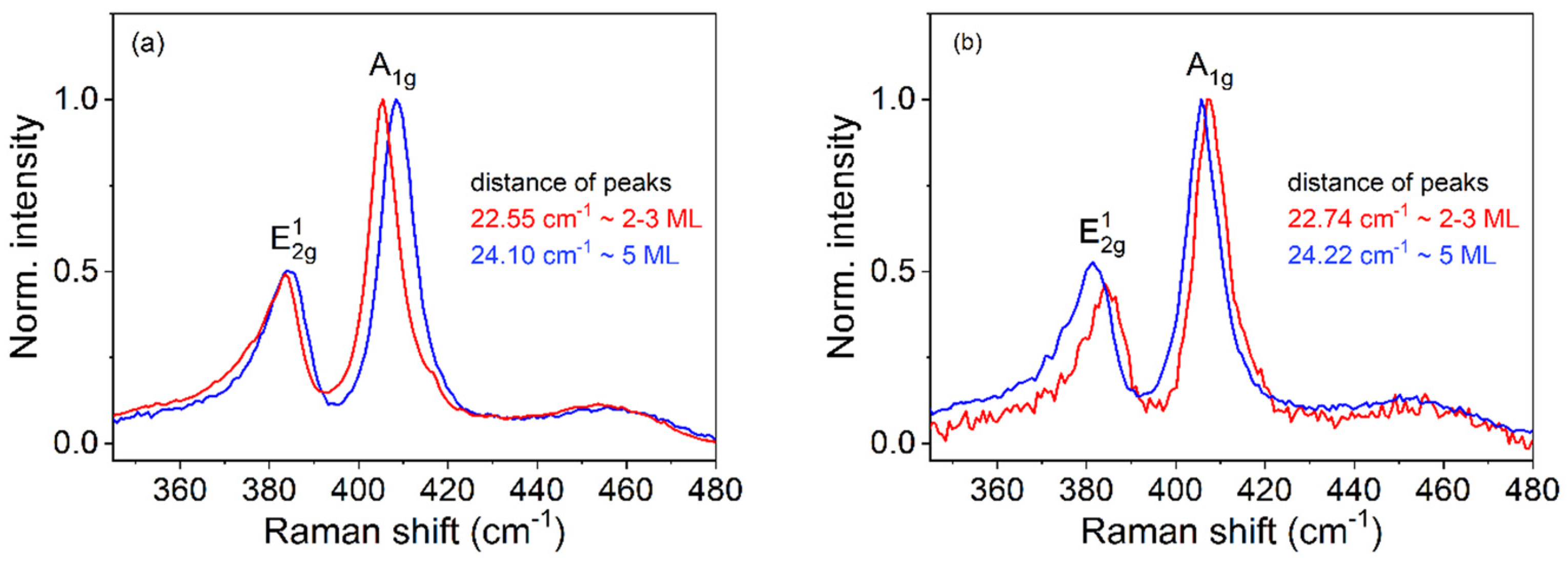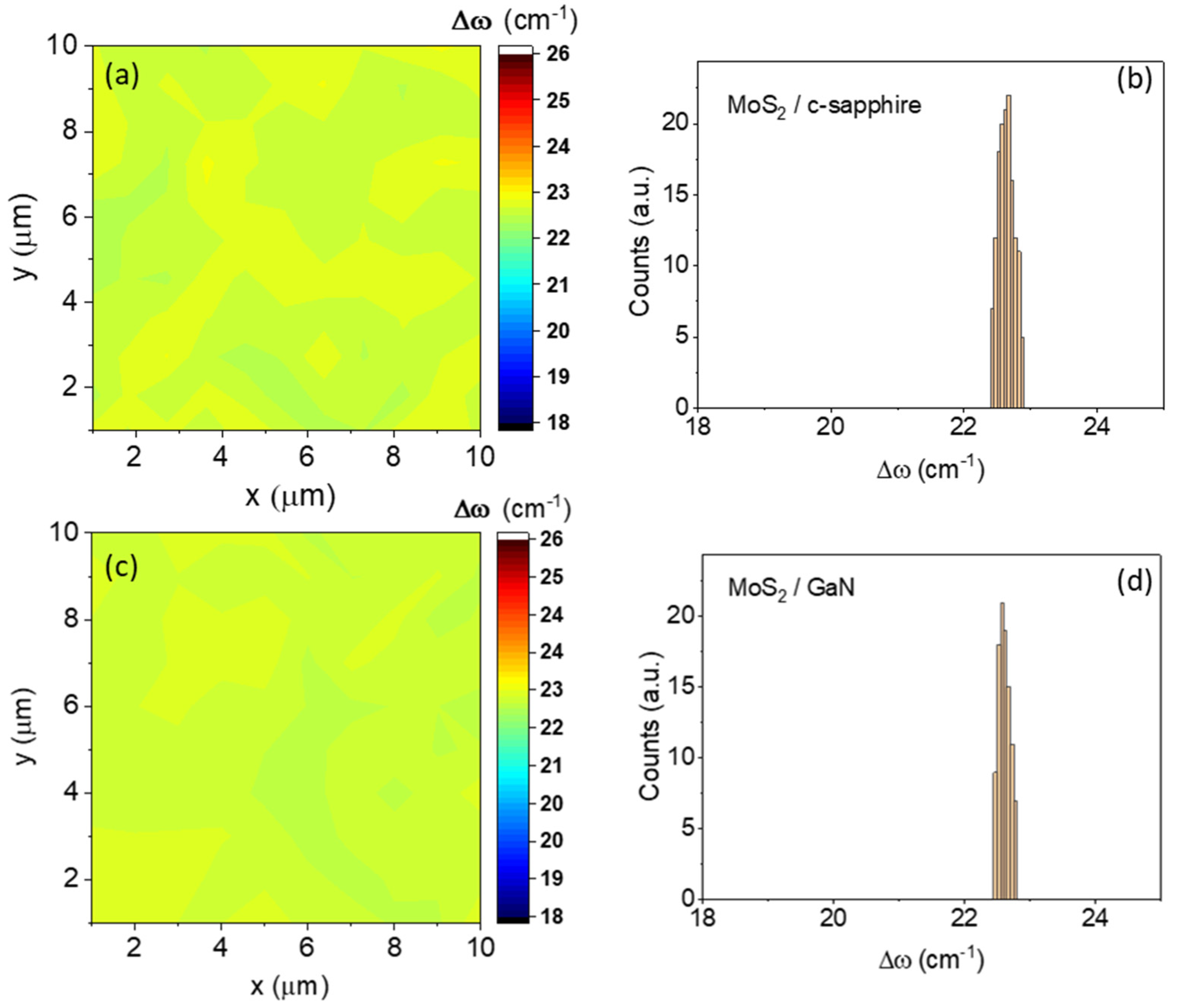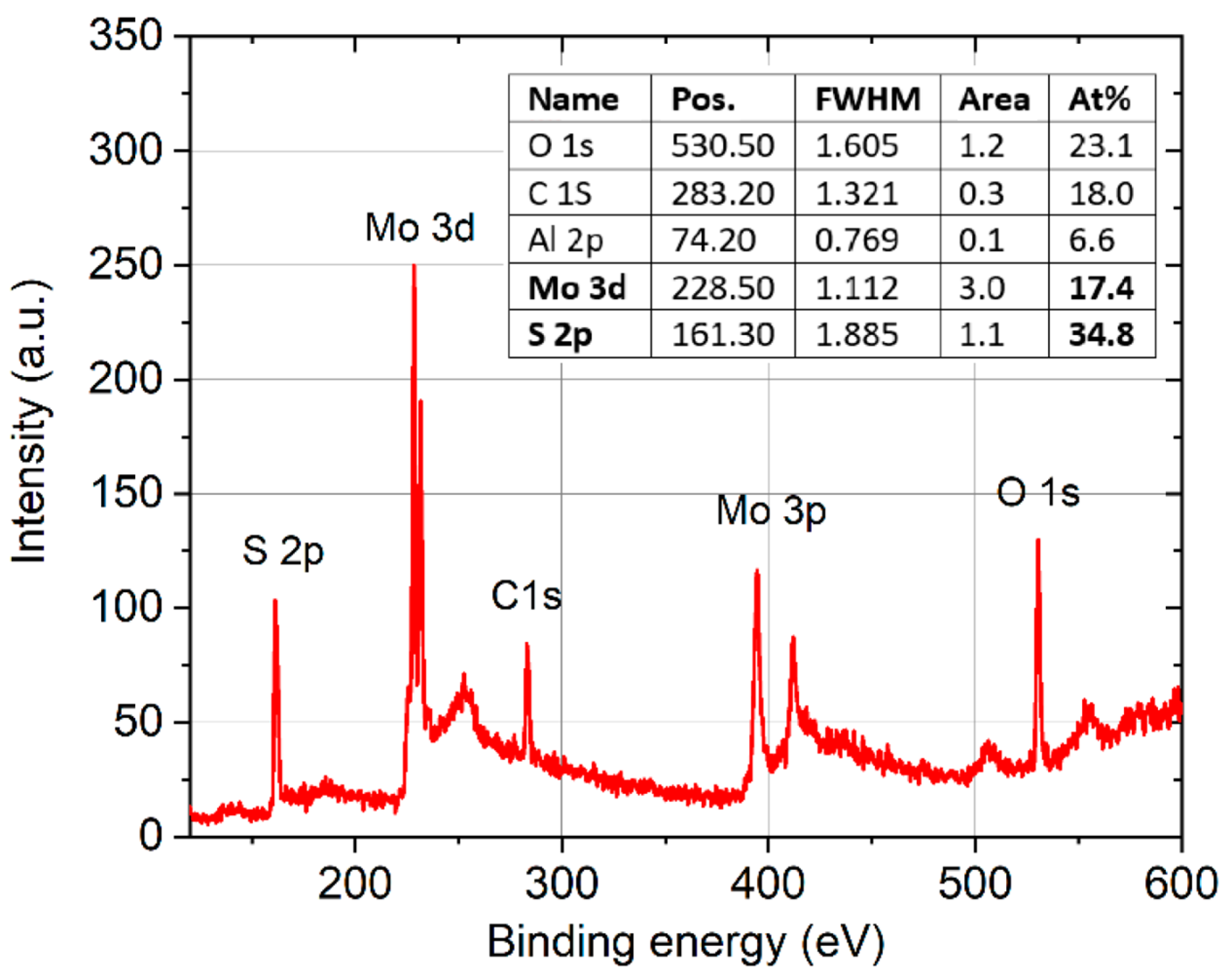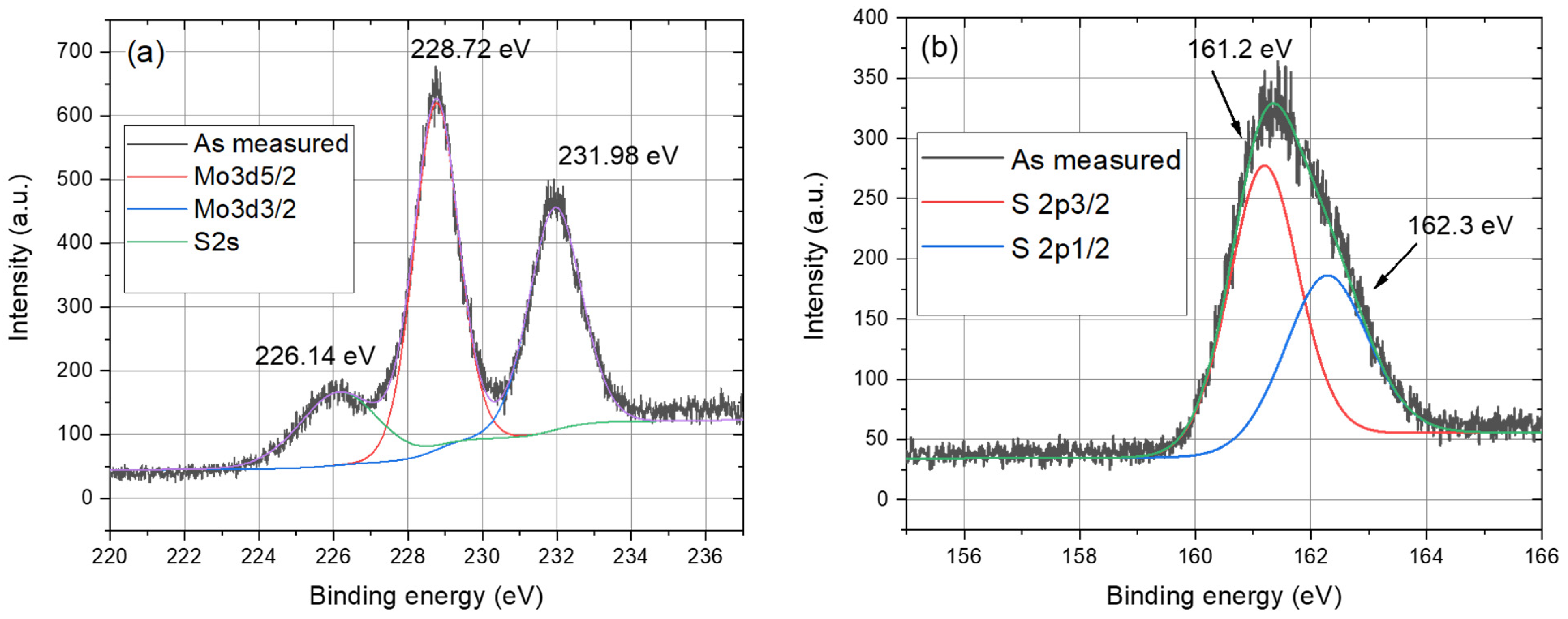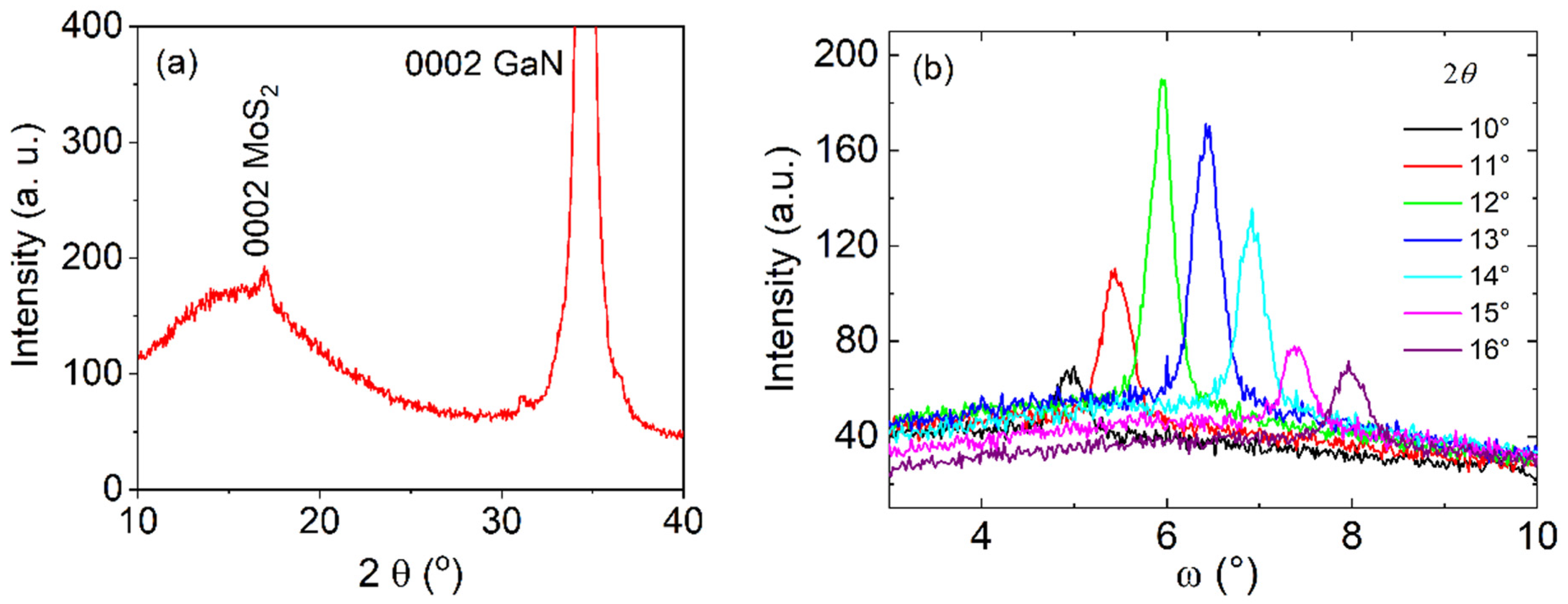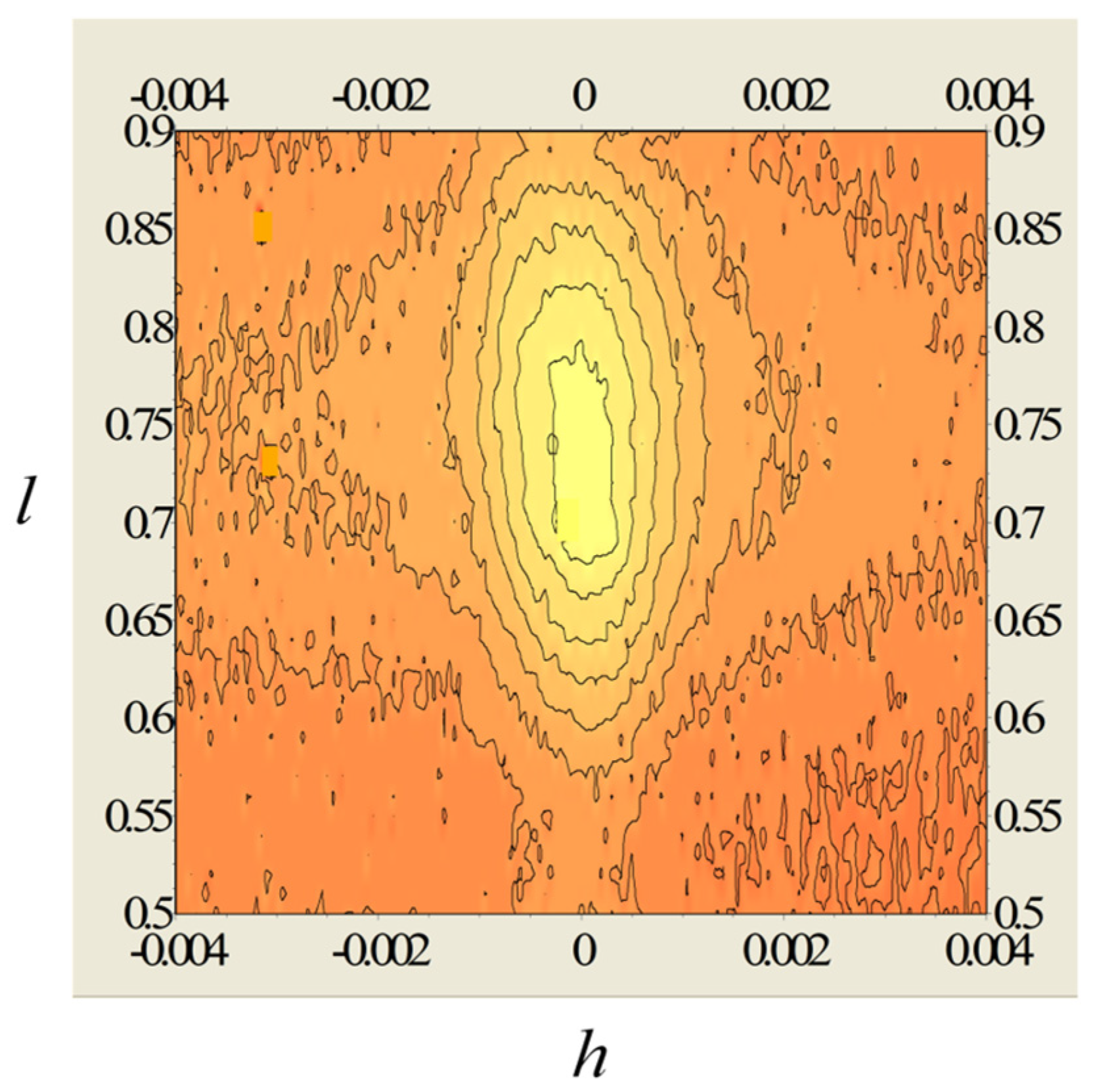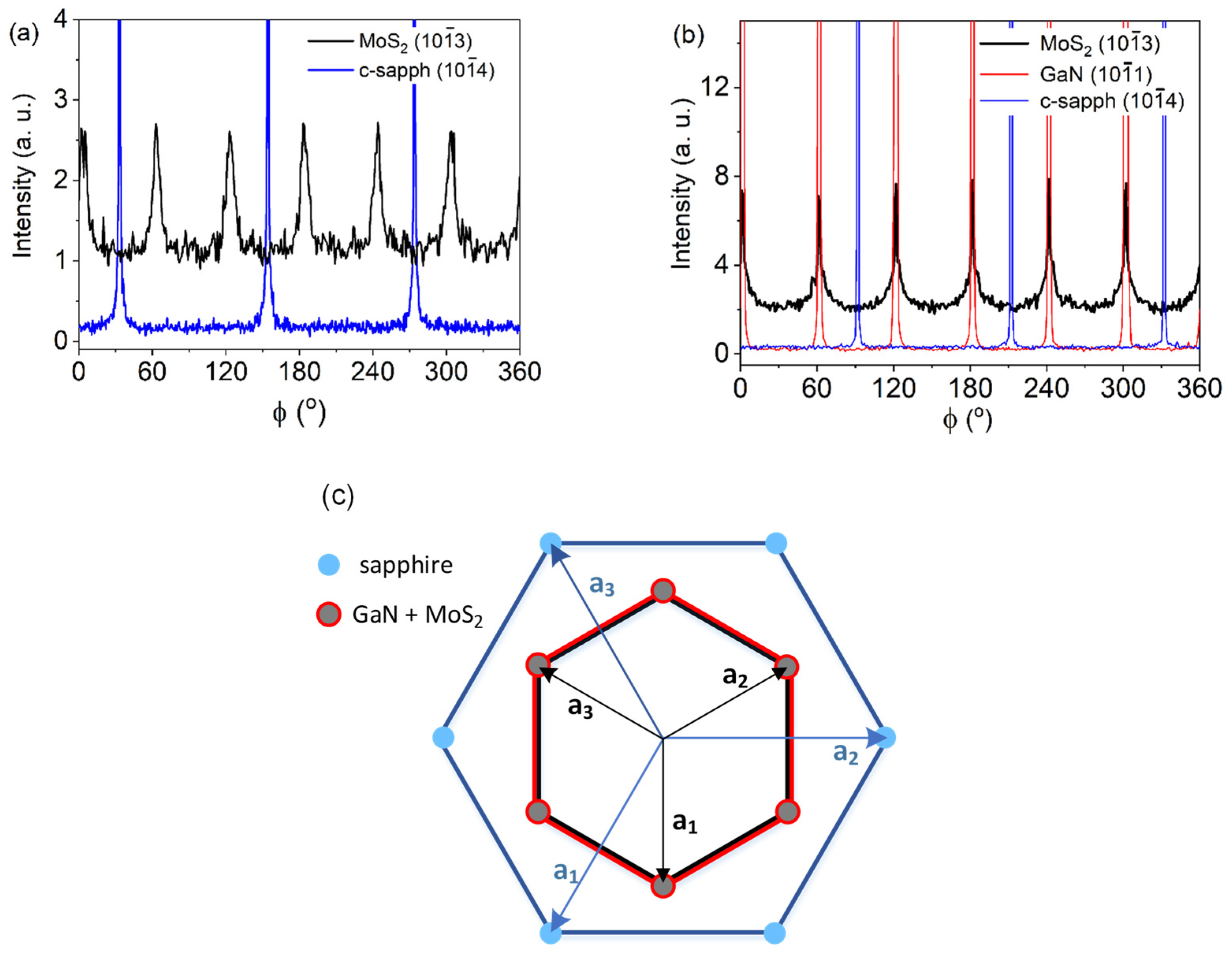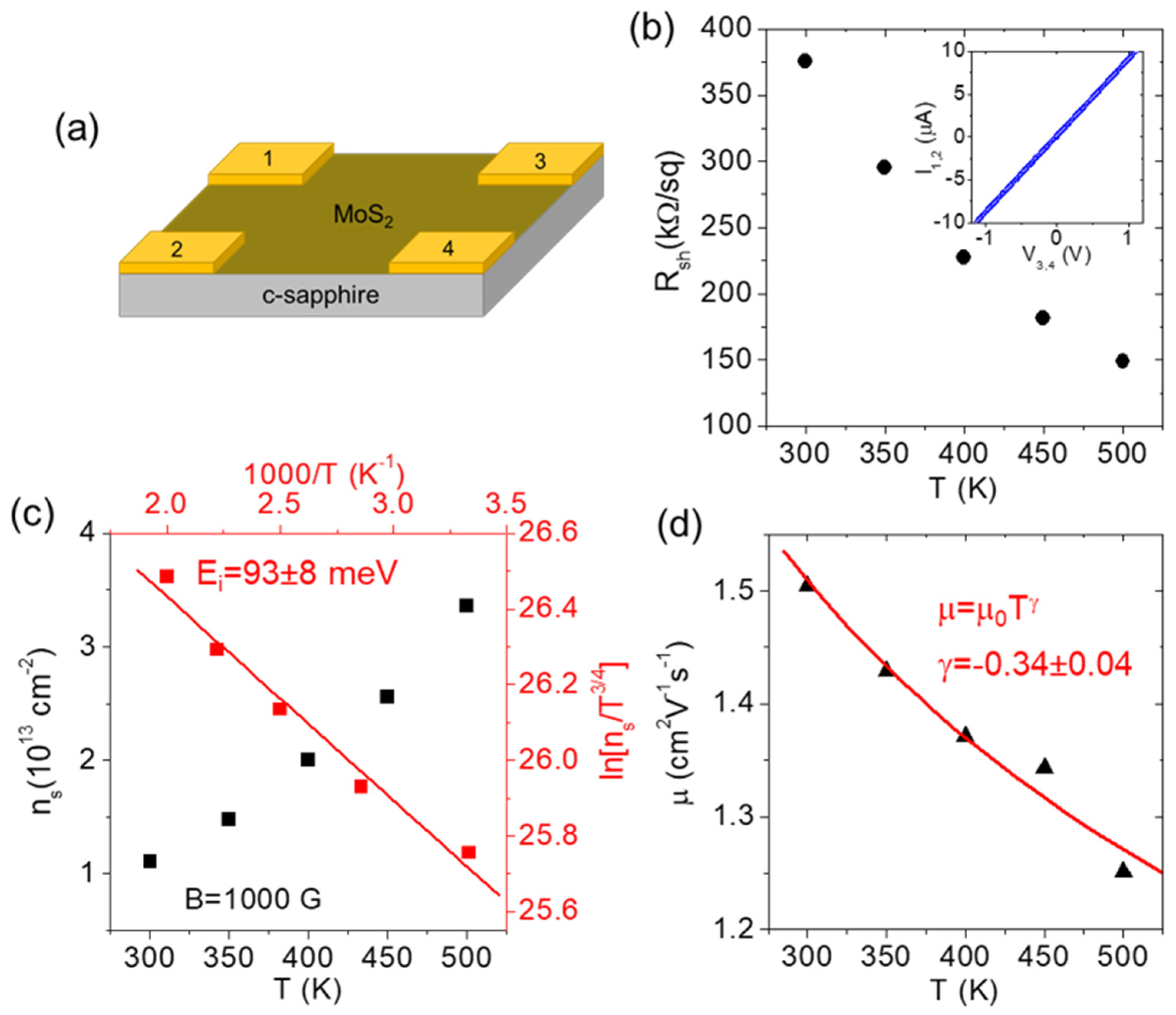1. Introduction
Two-dimensional layered (2D) transition metal dichalcogenides (TMDs), especially molybdenum disulfide (MoS
2), have attracted widespread attention due to their unique electronic, mechanical, and optical properties. Layered MoS
2 consists of a vertical stack of single layers 0.65 nm thick which are held together by van der Waals interactions. Depending on the number of MoS
2 monolayers, it can be possible to tune the bandgap of MoS
2. Monolayer MoS
2 exhibits a large direct bandgap of about 1.8 eV [
1], resulting in enhancement in the carrier mobility, which can be utilized for potential applications in next-generation electronic and optoelectronic [
2,
3,
4,
5] devices. Conventional approaches, such as Scotch-tape-assisted micromechanical exfoliation [
6,
7] or chemical exfoliation [
8], are not suitable for large-area device applications. The chemical vapor deposition (CVD) technique is considered one of the promising techniques for the growth of thin MoS
2 films [
9,
10]. However, it has some limitations, such as the precise control of the thickness uniformity, the substrate temperature, and the use of multiple precursors [
11]. One of the typical physical vapor deposition methods for the fabrication of 2D layered materials is pulsed laser deposition (PLD), which offers several advantages—the capability to produce large-area, few-monolayer-thick, highly crystalline MoS
2 films at relatively low substrate temperatures (the typical substrate temperature for PLD growth is 700 °C), as well as the stoichiometric transfer of the ablated material from the target to the substrate [
12,
13,
14]. In these studies, 2D MoS
2 thin films have been grown on Al
2O
3, GaN, and SiC-6H substrates. C-plane sapphire (Al
2O
3 (0001)) wafers are the most commonly employed substrates for growth of MoS
2-based 2D materials. This material is a chemically stable hexagonal single crystal, with 60°-rotation symmetry about its c-axis. GaN is a wide bandgap semiconductor and the ideal material of choice for high-frequency transistors (GaN HEMTs technology) and power-switching devices [
15,
16,
17], as well as for optoelectronic devices (LEDs and laser diodes). MoS
2 and GaN are suitable candidates for 2D/3D heterostructures, as low lattice parameter mismatch between these two materials (<1%) and similar thermal expansion coefficients promise high-quality epitaxial alignment between the materials [
18,
19,
20,
21].
In this article, we demonstrate the large-area PLD growth of highly uniform, few-monolayer-thick MoS
2 films on c-plane sapphire and heteroepitaxial GaN/sapphire substrates. The films are of excellent crystalline quality and thickness homogeneity, and we were able to prepare them on large-area surfaces, increasing the possibility of using these films for a wide range of applications. Noteworthily, and differently than in previous works [
12] where S-enriched MoS
2 targets were used to deposit MoS
2 films with the highest degree of crystallinity but with excess S content, we succeeded in depositing stoichiometric MoS
2 films from a target with a Mo:S ratio of 1:2. Furthermore, thanks to the absence of MoO
3 components in the as-deposited MoS
2 films, no need for additional post-deposition annealing in S is necessary to restore MoS
2 stoichiometry, in contrast to a finding reported in an earlier study [
14]. We employed various characterization techniques to investigate the structural and electrical properties of the prepared films. In particular, we provided a detailed analysis of the orientation relationship between the MoS
2 film and the c-sapphire and GaN substrates, for which few results are available in the literature. Furthermore, we provided a detailed electrical investigation of the in-plane transport properties of PLD-grown MoS
2 films on insulating sapphire substrates, extracting key physical parameters like the ionization energy of donors and providing insight into the limiting mechanisms of carrier mobility. To the best of our knowledge, this type of investigation has been not reported so far in PLD-grown MoS
2. The results are useful for benchmarking the electronic quality of the material produced by this approach compared to that of MoS
2 produced by alternative methods.
2. Materials and Methods
Two types of wafers, i.e., single-polished 10 × 10 mm
2 and 0.5 mm thick c-oriented ((0001) plane) sapphire and GaN (0001)/c-sapphire substrates, were used for the MoS
2 growth. The epitaxial GaN films with thicknesses of 4 μm were grown by means of metal–organic chemical vapor deposition on c-sapphire substrates [
22].
Few-monolayer (ML)-thick MoS2 films were prepared via PLD (MBE/PLD-2000 system). The setup consists of a KrF excimer laser with a 248 nm wavelength, mirrors, and a focusing lens. An energy laser pulse of 70 mJ, with a repetition rate of 4 Hz and a laser spot size of 2 mm2, was applied during the growth process. As a target, a commercially purchased stoichiometric MoS2 two inches in diameter was used. The target was rotated at a speed of 6 rpm and rastered to avoid pit formation. The distance from the target to the substrate was optimized at 10 cm. The substrate was heated by irradiation from the SiC heater, eliminating the need for direct contact between the heater and the substrate. This is a definite advantage as it allows us to rotate the substrates, enhancing the homogeneity of the deposited films, and the samples do not require any clamping or silver paste. The film growth was carried out at a deposition temperature of 860 °C under 2 × 10−6 Torr background pressure. The 860 °C was the temperature of the thermocouple, which was placed close to the SiC heater so it would show the actual temperature TS for a non-transparent Si substrate. In the case of a transparent sapphire substrate, this temperature was about 160 °C lower, i.e., in our case, TS~700 °C. After the film growth, the samples were cooled down to 200 °C at a rate of 50 °C/min before allowing for natural cooling. The final thickness of the MoS2 films was controlled by the number of pulses; typically, it was in the range between 400 and 800 pulses.
Raman spectroscopy was performed using an Alpha 300R micro-Raman system with a 532 nm excitation laser. The laser beam was focused by a 50× objective lens with a numerical aperture of 0.8. The acquisition time was 5 s, and the laser power was kept below 2 mW for all measurements. All of the spectra were acquired in ambient conditions.
X-ray photoelectron spectroscopy (XPS—Omicron multiprobe system with hemispherical analyzer, Scienta Omicron, Taunusstein, Germany) was performed using monochromatic Al K-alpha X-rays (1486.6 eV). All spectra were measured at an ambient temperature, with photoemission of 45° from the surface.
A Bruker D8 DISCOVER diffractometer equipped with a rotating Cu anode operating at 12 kW was used to determine the crystallographic orientation perpendicular to the film’s surface (symmetric 2θ/ω configuration). To specify the in-plane orientation of the MoS2 with respect to the substrate, ϕ-scans were carried out. All X-ray measurements were performed in parallel-beam geometry with a Goebel mirror in the primary beam.
High-resolution transmission electron microscopy (HR TEM) analyses were carried out with an aberration-corrected Thermofisher Themis 200 microscope (Thermo Fisher Scientific Inc., Waltham, MA, USA). Cross-sectional TEM specimens of MoS2/sapphire and MoS2/GaN/sapphire were prepared by a Ga FIB (focused ion beam) and finished at 2 kV. During the FIB process, a platinum coating was deposited in order to defend the lamella from the energetic gallium ions. We also evaporated an amorphous carbon layer, as we wanted to avoid close contact between the MoS2 and platinum particles.
The sheet resistance, carrier density, and mobility of the MoS2 grown on the sapphire substrate were evaluated by four-point probe and Hall effect measurements in the van der Pauw configuration. For this purpose, Ni(20 nm)/Au(80 nm) contacts were deposited by sputtering at the four corners of square-shaped (1 cm × 1 cm) MoS2/sapphire samples. Ohmic contacts on MoS2 were obtained with as-deposited Ni/Au stacks. The vertical current injection at the MoS2/GaN interface was probed at the nanoscale by conductive atomic force microscopy (C-AFM) with a DI3100 system by Bruker with Nanoscope V electronics, using Pt-coated conductive tips.
3. Results
We performed characterization using Raman spectroscopy in order to verify the thicknesses and properties of our MoS
2 films (
Figure 1a,b). Raman spectroscopy serves as a strong tool to determine the vibrational modes of TMDs. The characteristic Raman modes E
12g and A
1g are the most intense signals for the 2H-MoS
2 phase and can be used to determine the number of MoS
2 layers. This number depends on the difference Δω between the E
12g and A
1g peak wavenumbers. We obtained values of Δω~22.5–22.7 cm
−1 and ~24.2 cm
−1 for the MoS
2 films shown in
Figure 1a,b, corresponding to two to three monolayers (prepared by 400 laser pulses) and five monolayers (prepared by 800 laser pulses) of MoS
2, respectively. The thickness uniformity of the MoS
2 films was determined from arrays of 40 × 40 Raman spectra collected from an area measuring 10 × 10 µm.
Figure 2a,c show two representative color maps of the Δω values extracted from the arrays of spectra measured on MoS
2/sapphire and MoS
2/GaN surfaces, respectively.
Figure 2b,d are the histograms of the Δω values in the two maps, from which a very narrow distribution can be observed. The same results were obtained at different positions of the samples’ surfaces, demonstrating a high degree of thickness uniformity over a large area. Raman analyses demonstrated that MoS
2 films with nearly identical thicknesses were obtained by PLD on the sapphire and GaN/sapphire substrates.
High-resolution images taken in TEM mode and based on the lattice spacings show 2–3 monolayers of MoS
2 grown on c-sapphire, as well as on GaN/c-sapphire (
Figure 3a and
Figure 4a).
Figure 3b and
Figure 4b show cross-sectional scanning transmission electron microscopy (STEM) images taken with a high-angle annular dark field (HAADF) detector, called Z contrast. In the HAADF STEM image mode, Mo atoms, possessing a higher atomic number Z, exhibit significantly enhanced brightness, allowing for the detection of MoS
2 layers. The image in
Figure 4b shows 2–3 ML of MoS
2 in close contact to GaN; there is no oxide or amorphous layer on the top of GaN.
However, the periodic darker regions observed inside the GaN suggest the presence of potential damage or structural imperfections.
XPS was used to measure the chemical composition and stoichiometry of the MoS
2 samples. The evaluated atomic concentrations obtained from the survey spectrum confirmed the ideal stoichiometry of the MoS
2 films grown on both types of substrates, and we registered carbon on the top of the surface originating from elements of the atmosphere and substrate (
Figure 5). The Shirley background subtraction procedure was applied on the high-resolution spectra taken from the samples, and peak fitting was carried out through the selection of Gaussian–Lorentzian functions (
Figure 6).
Peak deconvolutions of the spectra revealed binding energies at 228.72 eV and 231.98 eV, corresponding to Mo
4+ 3d
5/2 and 3d
3/2 orbitals of 2H-MoS
2, respectively. The peak at 226.14 eV was assigned to the S 2s orbital. Additional peaks were observed from the doublet peak of MoS
2, S 2p
3/2, and S 2p
1/2 detected at 161.2 eV and 163.2 eV, respectively. The presence of the Mo 3d and S 2p states confirmed the formation of 2H MoS
2 [
23].
XRD analyses confirmed the preferential growth (with the c-axis perpendicular to the substrate plane) of the MoS
2 films grown on c-sapphire as well as on GaN/c-sapphire substrates (
Figure 7a). The standard 2θ/ω diffraction pattern presented in
Figure 7a reveals an extremely wide diffraction, 0002, of MoS
2. However, the rocking curves (
Figure 7b) recorded at different values of 2θ around the tabulated value 14.378° were surprisingly narrow; the values of the full width at half maximum (FWHM) varied between 0.3° and 0.4°. This indicates a very strange shape of the 0002 diffraction spot, which was elongated in reciprocal space (RS) along the direction perpendicular to the sample’s surface. This was confirmed by an RS map of the diffraction 0002, as shown in
Figure 8. The map is presented with the dimensionless linear coordinates
h and
l, introduced in RS in parallel and perpendicular directions with respect to the sample’s surface. They have the units
and
, respectively, where
is the interplanar distance of the corresponding lattice planes
hkil of the GaN. The advantage of the parameters
h and
l is that they acquire integer values at the diffraction spots of the substrate and make the interpretation and evaluation of the measurements quite easy. Note that, for greater clarity and better insight, the horizontal dimension of the map was 15 times enlarged with respect to its actual value.
The in-plane orientation relationship between the film and the substrate was examined through ϕ-scans of the strongest diffraction,
, of the hexagonal MoS
2 (
Figure 9a,b). A ϕ-scan of the
diffraction of the sapphire was also recorded. Six maxima of MoS
2 were detected, indicating the presence of a biaxial texture. The hexagonal MoS
2 lattice was rotated by an angle of 30° to the sapphire lattice (
Figure 9a), and the crystallographic orientation can be described as MoS
2 (0001)
‖ sapphire (0001)
. A similar situation occurred in the case of MoS
2 grown on the GaN/c-sapphire substrate. To reveal the orientation relationship of the in-plane ordered MoS
2 with respect to the GaN/c-sapphire, the ϕ-scan from the
diffraction of the GaN layer was measured beside the ϕ-scan of the
diffraction of the sapphire (
Figure 9b). In this case, the in-plane relationship between the MoS
2 and the GaN/c-sapphire substrate (
Figure 9c) was MoS
2 (0001)
‖ GaN (0001)
‖ sapphire (0001)
. To evaluate the “perfection” of the in-plane ordering, the FWHM values of the φ-scans of the
MoS
2 diffraction were estimated for the sapphire and the GaN/sapphire substrates. The obtained FWHM values were 9° and 8°, respectively, indicating the similar quality of the MoS
2 films grown on different substrates. For reference, the FWHMs of the φ-scans for the
sapphire and the
GaN diffractions were approximately 0.2° and 0.3°, respectively.
Electrical characterizations were finally carried out on the MoS
2 films grown on the sapphire and GaN/sapphire substrates. Firstly, the sheet resistance, carrier density, and mobility of PLD-grown MoS
2 on the insulating sapphire substrate were evaluated by four-point probe and Hall effect measurements in the van der Pauw configuration (see the schematic in
Figure 10a). After preliminarily checking that the as-deposited Ni/Au pads provided Ohmic contacts onto MoS
2 (see the insert in
Figure 10b), the temperature dependence of the sheet resistance (R
sh) was evaluated in a range from T = 300 to 500 K. As illustrated in
Figure 10b, a monotonic decrease in R
sh from ≈375 kΩ/sq to ≈150 kΩ/sq was observed with the increase in temperature in this range, as is consistent with the expected semiconducting behavior of the MoS
2 film. Furthermore, the Hall effect measurements, with an applied magnetic field B = 1000 G, showed an increase in the sheet electron density from n
s ≈ 1 × 10
13 cm
−2 to n
s ≈ 3.4 × 10
13 cm
−2. This was in the same temperature range (
Figure 10c, left axis) that was ascribed to the ionization of shallow donors with energy levels located below the MoS
2 conduction band. To evaluate the ionization energy E
i of these donor levels (i.e., their energy distance from the bottom of the conduction band E
i = E
c − E
D), we employed the neutrality equation for the approximation of a highly n-type doped semiconductor with a low level of acceptor compensation (N
D >> N
A) [
24]:
Here, k
B is the Boltzmann constant, N
D is the donor density, and N
C is the effective electron density in the MoS
2 conduction band, which depends on the temperature as N
c∝T
3/2. Such an approximation of a negligible compensation is justified, in part, by the nearly ideal stoichiometry of the PLD-grown MoS
2, without any MoO
3 contributions, as was deduced from the XPS analyses shown in
Figure 5 and
Figure 6. In fact, MoO
3 residues in the deposited films have recently been demonstrated to act with p-type doping levels, causing a significant compensation for the natural n-type doping of MoS
2 [
25]. Based on Equation (1), an Arrhenius plot of ln[n
sT
−3/4] vs. 1000/T is provided in right and top axis of
Figure 10c, and the ionization energy E
i = 93 ± 8 meV was obtained from the slope of the linear fit. Finally, the temperature dependence of the electron mobility μ was evaluated from the combination of the R
sh and n
s results, according to the relation μ = 1/(qn
sR
sh). A slight decrease in μ from ≈1.5 cm
2V
−1s
−1 to ≈1.25 cm
2V
−1s
−1 was observed by increasing T from 300 to 500 K, as illustrated in
Figure 10d. To obtain a deeper insight into the scattering mechanisms responsible for this decreasing trend in mobility, a fitting of the experimental data with the power function:
was also carried out (red line in
Figure 10d), from which a value of the exponent γ = −0.34 ± 0.04 was deduced. According to the literature results, the electron mobility in MoS
2 films is limited by two main scattering mechanisms depending on the sample temperature, i.e., the charged impurity scattering (which dominates at lower temperatures) and phonon scattering (which dominates at higher temperatures). Both the charged-impurities-limited mobility (μ
CI) and phonon-limited mobility (μ
ph) contributions are typically described by a power function of the temperature T (see Equation (2)), with positive and negative γ values, respectively [
26]. In particular, the theoretically predicted values of γ for optical-phonon-limited mobility could range from γ = −1.69 for monolayer MoS
2 to γ = −2.6 for bulk crystals [
27]. Clearly, the negative value of γ= −0.34, obtained by fitting of the experimental results, was significantly lower than these theoretical expectations. This indicates that, although phonon scattering played an important role, other competitive mechanisms contributed to limiting the electron mobility of our PLD-grown MoS
2. These may include not only charged impurity scattering, but also scattering by defects (such as grain boundaries of MoS
2 domains), which can account for this lower temperature dependence of electron mobility.
After investigating the lateral current transport in the thin MoS
2 films supported by the insulating sapphire substrate, we evaluated the vertical current injection across the 2D/3D semiconductor heterojunction formed by n-type MoS
2 with n-type GaN. To this aim, local current-voltage (I-V
tip) characteristics were acquired by applying a dc bias ramp between a nanometric-sized (r
tip = 5nm) Pt-coated AFM tip in contact with MoS
2 and a large metal contact, consisting of a Ni(20 nm)/Au(80 nm) stack, deposited on the bare GaN surface, as is schematically illustrated in the inset of
Figure 11a. This Ni/Au stack was not subjected to any thermal annealing in order to avoid the eventual structural modification of MoS
2. In this configuration, for geometric reasons, the I-V characteristics were sensitive to local current injection through the Pt/MoS
2/GaN vertical heterojunction, whereas current flow in the GaN layer and through the large metal contact introduced a series resistance contribution.
Figure 11a shows a set of four I-V characteristics collected at different positions on the deposited MoS
2 film. All of the curves exhibited rectifying behavior, with negligible current under negative polarization and current onset at the same forward bias. These characteristics are very reproducible under negative and small positive bias (V
tip < 1V), indicating the high uniformity of the MoS
2/GaN heterostructure. The main difference can be observed at a higher positive bias, which is related to series resistance contributions. A representative I-V curve is presented on a semi-log scale at a low forward bias in
Figure 11b, from which a linear increase in the current over two orders of magnitude can be observed from V = 0 to 0.25 V. This is followed by a bending, which is associated with series resistance. In this low-bias regime, we can assume that current injection from the Pt tip to MoS
2 can be ruled by direct tunneling (assumption justified by the high doping of MoS
2 deduced in
Figure 10c), whereas the MoS
2 heterojunction with n-GaN can be described as a Schottky junction using the thermionic emission equation:
In this equation, A
tip is the tip contact area, A* = 26.9 A cm
−2 K
−2 is the Richardson constant of GaN, k
B is the Boltzmann constant, ϕ
B is the Schottky barrier height at the MoS
2/GaN interface, and n is the ideality factor. In particular, a value of n = 2.2 was extracted from the slope of the linear fit in
Figure 11b, and a barrier height of ϕ
B = 0.36 eV was evaluated from the intercept with the current axis. This ϕ
B value corresponds to a small conduction band discontinuity between n-type MoS
2 and n-GaN, as is consistent with the results reported in several recent investigations of this heterostructure [
28,
29]. The deviation of the ideality factor from n = 1 indicates the presence of non-idealities at the heterojunction.
